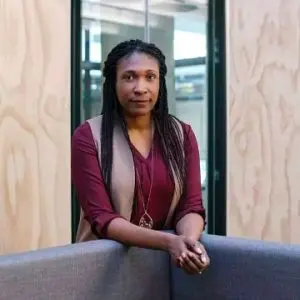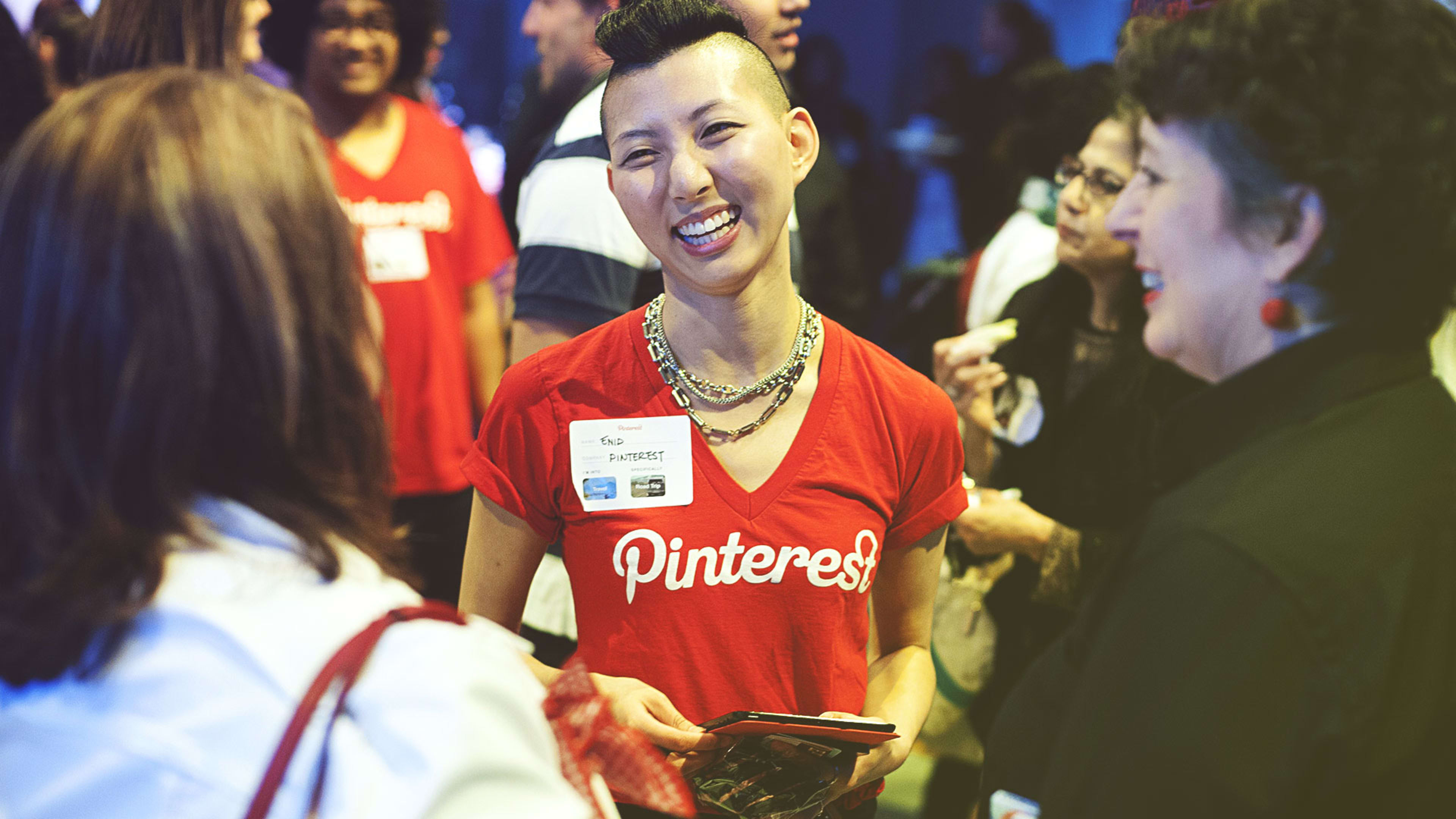When Candice Morgan was appointed to head up Pinterest’s diversity and inclusion efforts in January 2016, she described the then–700-person company’s hiring goals as “aggressive for a reason.” “They were based on research, looking at the talent pool, who is available, and who is coming out of certain programs. They were thoughtfully crafted,” Morgan told Fast Company. Then she observed, “In the world of diversity, things take time.”
Time has passed, and in the year and a half since, Pinterest has added some 400 new staffers, seen some progress, and had a few hiccups.
While the company hasn’t officially shared diversity data since last December, those numbers reflected a year of dedicated effort as its headcount grew dramatically. Women in technical roles has increased from 21% to 26%, and those from underrepresented ethnic backgrounds increased to 7%. The hiring rate of engineers from underrepresented ethnic groups went from 1% to 9%.
However, in a recent Harvard Business Review piece, Morgan admits Pinterest missed its goal of hiring women into 30% of its engineering roles. “What I realized,” she tells Fast Company, “is that we actually had the wrong goal initially.” Fresh off a hiring spree, Pinterest is as aggressive on diversity as ever, Morgan explains, but approaching its goals more holistically than it has in the past—and arguably more so than its peers in the present.
Related: How These Seven Tech Leaders Are Tackling Diversity In 2017
Breaking Down Percentages
Morgan says that Pinterest’s female senior engineers “came to us and said, ‘We don’t want to create this stigma where we really skew the ratio of women engineers toward junior engineers. That’s not helpful for us and that doesn’t help us create more role models.’ And they’re absolutely right.”

It’s a sign that Pinterest has taken this to heart that the company has set two distinct goals: one for underrepresented professionals across the company and another for engineering specifically. Morgan says Pinterest’s leadership and recruiting team realized there needed to be more nuance when hiring. Hiring 30% women engineers “is attainable if you’re focused on volume,” she explains. “We could’ve just really focused on new graduates and attained that goal.”
But that would leave leadership ranks untouched. “What that goal doesn’t take into account is that we want women across the entire leadership and pipeline level in engineering,” Morgan says. At the senior level at Pinterest, female staff made up only 5% of all tenured employees–a big deficit. “So for the second half of the year, we focused on just hiring senior women, and we actually did that across our engineering pool,” she explains.
The Rooney Rule Is Working
That includes Pinterest’s new head of engineering, Li Fan, who joined last September after a total of more than 10 years at Google (broken up by nearly four years at Baidu), where she held senior engineering positions including heading up Image Search.

“That [initiative] has actually been very, very successful for us,” Morgan says. “We actually had hundreds of candidates that we looked at who were women for the head of engineering role, even though women are under 5% of that talent pool.” The best candidate for the role happened to be a woman, she says, but Morgan sees Fan’s hiring as important for two reasons: One, appointing a female head engineer was a first not just for Pinterest but has rarely happened before in the tech sector at large. “Two, because it shows our senior women engineers that they could lead the department,” she explains. “I believe that that is a result of the extra vigilance of the Rooney Rule.”
Related: Why Salesforce’s New Equality Chief Is Thinking Beyond Diversity
Morgan also notes that in 2016, Pinterest went from having no underrepresented minorities on its executive team (the group reporting directly to the CEO) to 10%, and over 20% of those senior execs are now women—a significant change over the past year, despite being a small percentage uptick from the industry average, which hovers in the teens.
“Pre-Sourcing” Talent, Then Hanging Onto It
While Pinterest hopes to build on this progress in its upper ranks, the company is paying attention to its junior hires, too—in other words, its “pipeline.” Morgan points to Pinterest’s apprenticeship program, which got underway around the time she came on board. Since then Morgan says it’s helped the company add more people from diverse educational and experiential backgrounds to its talent pool. Pinterest hired its first three apprentices full time this year and plans to double the program next year.
On the pipeline issue, Morgan concedes “sometimes it’s an excuse not to try harder” but suggests that Pinterest prefers to see it as a challenge. For example, the company successfully raised the share of engineering applicants (including for internships) from underrepresented groups to 50%. “Previously, that number was a lot lower, so if we had just said, ‘Well, that’s okay because it’s on par with the pipeline [typically], we wouldn’t have made that progress,” she says.
Instead, Pinterest deliberately expanded the list of schools on its go-to recruiting list, adding more historically black colleges, for example. Morgan says the company also “started pre-sourcing students” before even going to campus, by meeting them at industry-based student groups, for instance, and working with the National Society of Black Engineers and other organizations. While there were more women graduating with computer-science degrees in the late ’70s and early ’80s than today, Morgan argues they’re still out there, “and if we don’t look harder for them, instead of expecting them to just come to us, then we don’t benefit.”
On the heels of adding so many new employees–and continuing to hire more–Pinterest now has to make sure its retention goals hold steady. As Morgan sees it, that involves making sure “that the hiring managers understand what we’re trying to do really well.” Faced with fewer open positions to fill, recruiters have more time to sort through candidates. “But when hiring teams are making very quick decisions,” she points out, they “need to understand how important it is to factor in that we want different types of people at the table building this product.” Speedy hiring can sometimes hold hidden costs that don’t appear until later, when people start leaving.
Related: Why Diversity In Hiring Is Just One Part Of The Puzzle
Rethinking Retention
Pinterest has become more attuned to the subtleties of retention issues in the process, says Morgan. “You can focus on making sure that the retention rates of your underrepresented communities within your workforce are no different from the overall retention rate,” she says. So if there’s spiking in the former, it’s a red flag.
Many companies focus on only voluntary attrition, but Morgan believes that’s an imperfect measure, not least because bias can influence how people are evaluated. “So we make sure that our retention goals are tracking both [of those factors].” So far, she says Pinterest’s retention rate for women is strong but that the company will continue to monitor departures across all underrepresented groups. Unlike Intel, Pinterest only shares those figures with senior leadership at this time.
Morgan recognizes how closely retention is tied to culture. If new hires arrive only to discover low representation and managers who don’t think very hard about inclusion, they aren’t likely to stay long. She adds, “No one wants to be a token.” she adds.
To combat this, Pinterest tries to offer employees at all levels—but especially interns and entry-level staffers—both technical and non-technical mentors to help them along. “You want to know that someone is there fighting for you, and that person doesn’t necessarily have to be of the same background,” Morgan explains, “but it has to be someone who’s actually interested in taking care of you, and is invested in your career, and likes to manage people.”
Morgan admits that keeping diversity a priority is a constant challenge, especially when a business is establishing itself. It requires the CEO and executive team to invest and keep it top of mind, both inside the company and out–“not just talking about it, but rewarding people for it,” says Morgan. “That accountability is super important.”
Recognize your brand’s excellence by applying to this year’s Brands That Matter Awards before the early-rate deadline, May 3.
